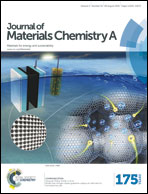Optimizing semiconductor thin films with smooth surfaces and well-interconnected networks for high-performance perovskite solar cells†
Abstract
An efficient solution-based technique to grow homogeneous TiO2 nanoparticle (TNP) thin films with tunable crystal size, porosity and roughness on a transparent conducting oxide (TCO) substrate is demonstrated that can direct the evolution of an optimal perovskite morphology. Combining a gas-assisted spin-coating and a subsequent blended vapor-assisted annealing protocol, highly crystalline perovskite films with a flat surface, reduced pin-holes and micrometer-scale grains were formed. The blended vapor was produced from a mixed N,N-dimethylformamide (DMF) and chlorobenzene (CBZ) solution. In the mixed vapor-assisted annealing, the DMF vapor molecules dissolved small perovskite grains and the anti-solvent CBZ facilitated rapid precipitation of perovskite crystals filling the gaps and pores among adjacent grains to produce high quality perovskite films. Perovskite solar cells with consistent power conversion efficiencies exceeding 15% and little cell-to-cell variability have been obtained. This work shows that fine tuning of the semiconducting networks by simple chemistry methods, can potentially lead to the fabrication of high-performance and cost-effective thin film solar cells.


 Please wait while we load your content...
Please wait while we load your content...